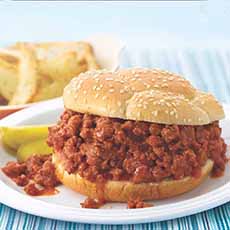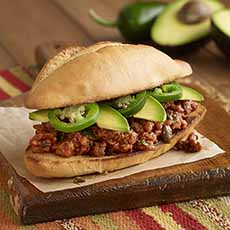RECIPE: Gourmet Sloppy Joe For National Sloppy Joe Day
|
When we first discovered March 18th to be National Sloppy Joe Day, our only experiences with a Sloppy Joe sandwich were in our high school cafeteria. Instead of a hamburger, Sloppy Joe stretched the ground beef with onions, ketchup, maybe with some Worcestershire sauce, and maybe other seasonings (although high school cafeterias are not known for seasoning finesse). Modern cooks have upgraded the recipe, some taking a “gourmet” approach. See the recipe below, as well as our suggestions for “>ways to glamorize your Sloppy Joe. But first, a bit of… The Sloppy Joe originated in the U.S. during the early 20th century. Early and mid-20th century American cookbooks offer quite a few Sloppy Joe-type recipes, although they can go by different names: Chopped Meat Sandwiches, Hamburg à la Creole, Minced Beef Spanish Style, Spanish Hamburgers and Toasted Deviled Hamburgers, among others. (May we say…all of these names sound more appetizing than Sloppy Joe.) Research done by H.J. Heinz says that it seems that the sandwich named Sloppy Joe originated with the “loose meat sandwiches*” sold in Sioux City, Iowa, in the 1930s. Not surprisingly, they were the creation of a cook named Joe. A Sloppy Joe differs from a traditional loose meat or tavern sandwich* due largely to its tomato-based sauce. References to Sloppy Joe sandwiches begin by the 1940s [source]. It was affordable comfort food, and by the 1960s, food companies began producing packaged Sloppy Joe in cans with meat, or just the sauce. One example is Manwich (photo #7), a sauce made by Hunt’s that can be used to make Sloppy Joes (tomato paste, HFCS, distilled vinegar, spices). It’s easy to upgrade the conventional Sloppy Joe with: If you prefer a spicier alternative to the Italian seasoning, substitute 1 tablespoon of chili powder and 1 teaspoon of cumin. Note that you can make this recipe a day in advance and let the flavors meld overnight. 1. PREHEAT the oven to 400°F. Line a baking sheet with foil. 2. COMBINE the onion, carrot, celery and bell pepper in a bowl with 2 tablespoons of olive oil and the tomato paste. Toss to evenly coat. Spread out on the baking sheet. 3. SLICE off the top of the garlic head so that the cloves are exposed. Drizzle a 1/2 tablespoon of olive oil over the top and then wrap the garlic in foil. Place it on the baking sheet with the vegetables. 4. PLACE the baking sheet in the oven and roast for 40 minutes. Remove from the oven and allow to cool. Meanwhile… 5. HEAT another tablespoon of olive oil in a large pan over medium heat. Add the ground beef and Italian seasoning and cook, breaking the beef apart with a spatula, until browned. Drain the grease. 6. ADD the wine and raise the heat until most of the liquid has evaporated. 7. CHOP the cooled vegetables into small pieces. Add them to the pan of ground beef and stir to combine. 8. SQUEEZE the garlic cloves from the head and mash to a paste-like consistency. Stir them into the meat mixture. 9. ADD the chicken stock, tomato pureé, Worcestershire sauce and brown sugar to the pan. Bring to a simmer and reduce the heat to medium-low. Let simmer for at least 20 or 30 minutes, or until the sauce has thickened. If the mix doesn’t thicken to your desired consistency, blend 1 tablespoon cornstarch and 1 tablespoon water. Stir into the pan and and simmer until thickened. 10. CHECK the seasoning and add salt and pepper to taste. Serve on rolls. Recipe adapted from Girl Gourmet. |
|
|
|
_________________ *A tavern sandwich, also called a loose meat sandwich, consists of ground beef mixed with sauteed onions on a bun, sometimes topped with pickles, ketchup, mustard, and cheese. †The legend is that the loose meat sandwich (subsequently given the fancier name of “tavern sandwich”) was invented in 1924 by a man named Dave Higgin at Ye Olde Tavern in Sioux City, Iowa. Here’s more about it. If you don’t want to buy Italian seasoning, here’s a recipe using the dried herbs that you have. Blend 1-1/2 teaspoons dried oregano, 1 teaspoon dried marjoram, 1 teaspoon dried thyme, 1/2 teaspoon dried basil, 1/2 teaspoon dried rosemary, 1/2 teaspoon dried sage. Keep in a jar, tightly closed. CHECK OUT WHAT’S HAPPENING ON OUR HOME PAGE, THENIBBLE.COM.
|
||









